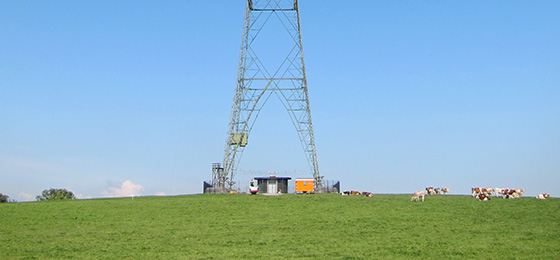Monitoring greenhouse gas emissions independently

The signatory countries of the Kyoto Protocol and the new Paris Agreement have committed to reduce global warming. The countries themselves use estimates and projections to verify whether they are actually achieving the necessary reduction in greenhouse gases.
The uncertainties are considerable and mistakes do happen. Researchers funded by the Swiss National Science Foundation (SNSF) have developed a method to independently monitor these statistics by making direct measurements of the gases in the atmosphere (*).
Hardly any natural gas pipeline leaks
Researchers at Empa in Dübendorf, the University of Bern and ETH Zurich combined the data measured for methane (CH4) with a transport model for air pollutants in Switzerland. The result: The values for 2013 diverged only marginally from the figures published by the Federal Office for the Environment (FOEN) and confirmed the estimated annual emission of approximately 200,000 tonnes of methane.
The proportion of methane emissions caused by livestock farming, contributing the lion's share of 70 percent, was found to be somewhat lower than previously estimated. On the other hand, it was confirmed that gas pipeline leaks in Switzerland’s towns and cities were only a minor source of methane. The assumptions here had always been highly uncertain. Surprisingly, the volume of methane emissions in north-eastern Switzerland was higher than assumed.
“We are now planning a measurement campaign closer to the relevant areas to verify whether the difference is actually real,” says Dominik Brunner, atmospheric physicist and study leader at Empa.
For the model simulations, Brunner and his colleagues integrated data from two new measuring stations (installed specifically for the project) on the Lägeren mountain near Baden and on the former radio transmission tower at Beromünster (canton of Lucerne), as well as data from two more locations on the Swiss plateau. A small number of locations were sufficient for determining methane emissions in Switzerland since, thanks to the weather model of the Federal Office of Meteorology and Climatology (MeteoSwiss), the intricate trajectories of air parcels can be traced back several days across to the Atlantic.
Widening the European monitoring network
“We have improved on the resolution of the inverse modelling already applied to larger areas such as the USA and scaled it to Switzerland's challenging topography,” remarks Stephan Henne, the first author of the study. The FOEN plans to publish the study as an annex to Switzerland’s latest greenhouse gas inventory on 15 April 2016. This makes Switzerland one of only three countries, including the UK and Australia, to publish an independent validation of its figures.
The project CarboCount-CH can be considered a pilot for the pan-European observation network “Integrated Carbon Observation System” (ICOS), which is currently being set up to monitor greenhouse gas emission at the European scale. Henne: “Our next CarboCount-CH project will be an investigation of carbon dioxide (CO2) uptake by vegetation.”
(*) S. Henne, D. Brunner, B. Oney, M. Leuenberger et al. (2015). Validation of the Swiss methane emission inventory by atmospheric observations and inverse modelling. Atmospheric Chemistry and Physics. http://dx.doi.org/10.5194/acpd-15-35417-2015 (Open Access)
Project on the database P3 http://p3.snf.ch/project-136273
Contact details
Dr Dominik Brunner
Laboratory for Air Pollution/Environmental Technology
Empa Dübendorf
Tel.: +41 58 765 4944
e-mail: dominik.brunner@empa.ch
The text of this press release is available on the website of the Swiss National Science Foundation: www.snf.ch > Research in Focus > Media > Press releases
http://www.snf.ch/en/researchinFocus/newsroom/Pages/news-160322-press-release-mo…
Media Contact
All latest news from the category: Ecology, The Environment and Conservation
This complex theme deals primarily with interactions between organisms and the environmental factors that impact them, but to a greater extent between individual inanimate environmental factors.
innovations-report offers informative reports and articles on topics such as climate protection, landscape conservation, ecological systems, wildlife and nature parks and ecosystem efficiency and balance.
Newest articles

NASA: Mystery of life’s handedness deepens
The mystery of why life uses molecules with specific orientations has deepened with a NASA-funded discovery that RNA — a key molecule thought to have potentially held the instructions for…

What are the effects of historic lithium mining on water quality?
Study reveals low levels of common contaminants but high levels of other elements in waters associated with an abandoned lithium mine. Lithium ore and mining waste from a historic lithium…

Quantum-inspired design boosts efficiency of heat-to-electricity conversion
Rice engineers take unconventional route to improving thermophotovoltaic systems. Researchers at Rice University have found a new way to improve a key element of thermophotovoltaic (TPV) systems, which convert heat…



